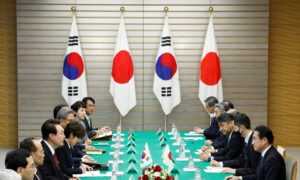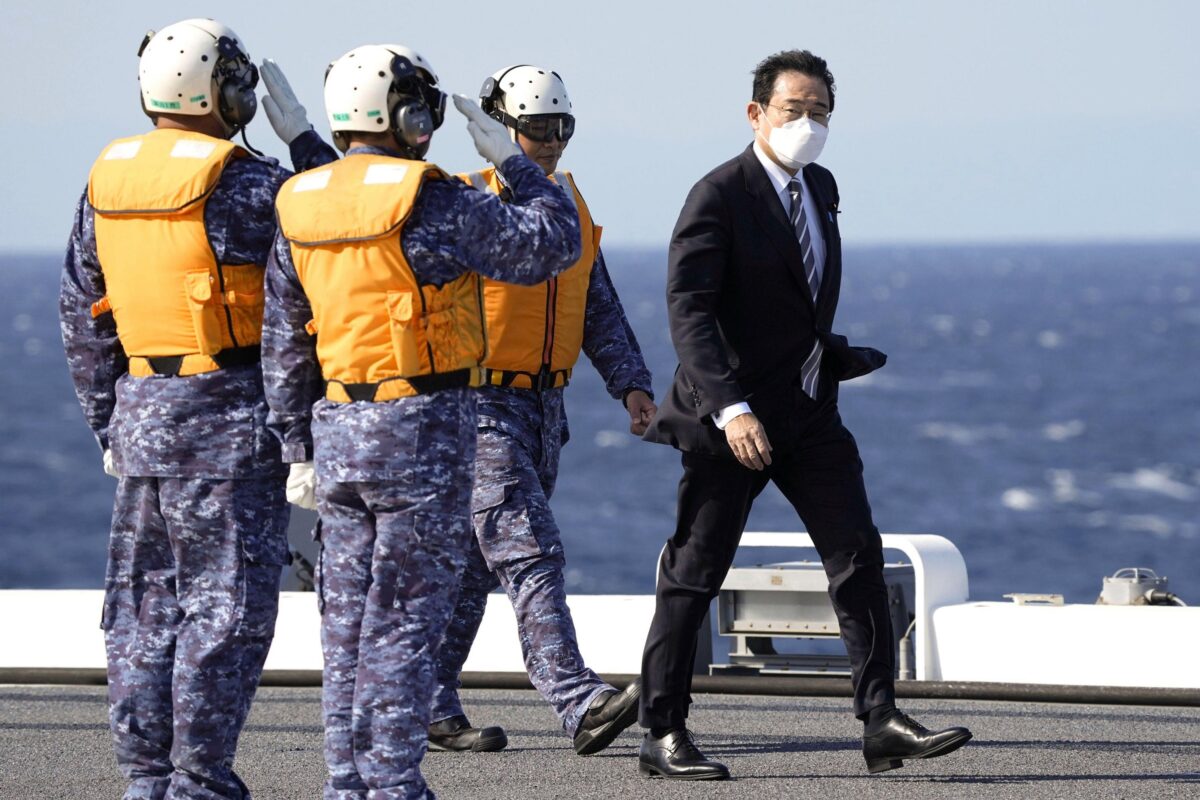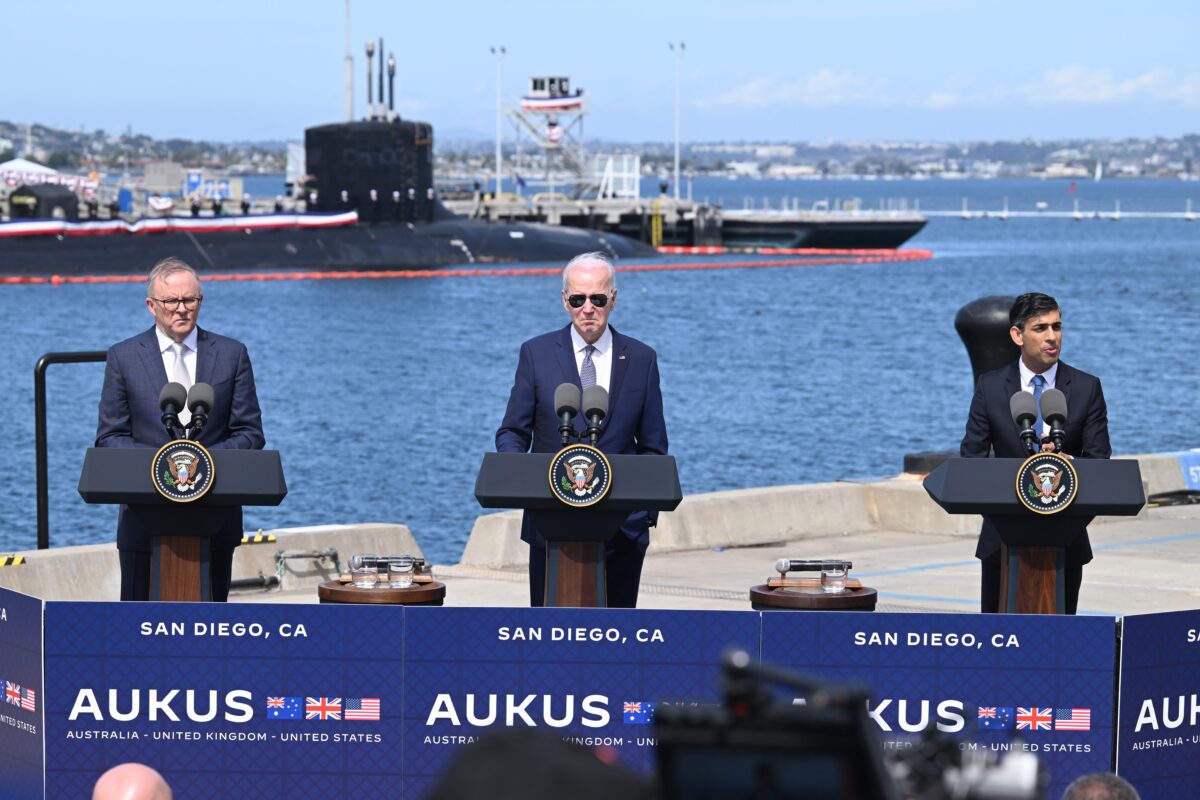US Security Alliances in Asia Get Stronger
Commentary It seems that China has been able to accomplish something that 70 years of U.S. diplomacy could never achieve: push Japan and South Korea closer toward something like a strategic partnership. Earlier this month, South Korean President Yoon Suk-yeol flew to Tokyo to meet with his Japanese counterpart, Prime Minster Fumio Kishida—the first official visit of a South Korean president to Tokyo in twelve years. This summit was no small thing, given long-standing chilly relations between Tokyo and Seoul. If Japan and the United States see themselves in “strategic competition” with China, South Korea has historically viewed Japan as its main competitor. Korean animosity toward Tokyo is rooted in Japan’s brutal occupation of the Korean peninsula from 1910 to 1945, when Korean culture and language were suppressed and Japan used Koreans as a source of slave labor (and worse). South Korea’s postwar economic miracle was partly motivated by its desire to outperform Japan in the latter’s traditional industrial bulwarks; hence, South Korea’s drive to excel in automobiles, shipbuilding, and electronics. At the same time, Seoul did not generally view China as an aggressor. The Chinese and the Koreans have much in common culturally and historically; China traditionally acted as Korea’s protector against the Japanese. After the two countries normalized relations in the early 1980s, trade and other economic relations bloomed. Despite having a close military alliance with the United States, Seoul always shied away from widening this into a trilateral security pact with Tokyo. This could be changing and, if so, it will be Beijing’s own fault. China’s growing aggressiveness in Asia is worrying even the normally blasé South Koreans. Claims of illegal fishing in Korean waters by Chinese vessels, and Beijing’s ham-fisted response to Seoul permitting the United States to deploy THAAD air-defense systems to Korea, have soured relations between the two countries. So when Yoon met with Kishida it was considered a big deal. In particular, the two leaders were able to resolve a key sticking point in South Korean-Japanese ties: an agreement to compensate Koreans enslaved by Japanese companies during the occupation (albeit using South Korean funds—something that has upset many Koreans, who feel the Japanese are escaping blame). Japan and South Korea will, as The Washington Post put it, expand “cooperation on everything from intelligence-sharing to supply chains.” Japanese Prime Minister Fumio Kishida walks on the deck of the Japanese Maritime Self Defense Force’s helicopter carrier JS Izumo during an international fleet review in Sagami Bay, southwest of Tokyo, on Nov. 6, 2022. (Kyodo News via AP) This Seoul-Tokyo rapprochement could presage the kind of multinational Asian security alliance that Washington has long coveted. Japan has been rapidly jettisoning much of its postwar pacifism (although not without protest), announcing its intentions to double defense spending over the next five years and buy new offensive weapons. Normally this would have provoked a hue and cry from Seoul, but that uproar has gone silent. Instead, President Yoon has stated that Japan has “transformed from a militaristic aggressor of the past into a partner that shares the same universal values with us.” This nascent Washington-Tokyo-Seoul axis could soon be supplemented by additional partners. The Unites States is rebuilding its military relations with the Philippines, which has been made easier by the exit of the more pro-China President Rodrigo Duterte. Washington and Manila have expanded their 2014 Enhanced Defense Cooperation Agreement, and additional U.S. troops will be stationed in the Philippines. The AUKUS pact between the United States, Australia, and the United Kingdom is beginning to firm up as well. The United States has agreed, as a first step, to provide Australia with nuclear-powered submarines, either through sale or lease. Over the long term, the United States and Britain will transfer technology to Australia to allow it to construct its own nuclear submarines, with perhaps as many as eight boats. In addition, Britain and the United States will rotate the deployment of nuclear-powered submarines to HMAS Stirling, located near Perth on Australia’s west coast. International crewing of these boats is also possible. Australian Prime Minister Anthony Albanese (L), U.S. President Joe Biden (C), and British Prime Minister Rishi Sunak hold a press conference after a trilateral meeting during the AUKUS summit in San Diego, Calif., on March 13, 2023. (Leon Neal/Getty Images) It might appear that U.S. efforts to contain China geopolitically are succeeding wildly. Certainly in Northeast Asia, China is increasingly hemmed in, especially as Tokyo has come to see the security and self-determination of Taiwan as critical to Japan’s own security. Along with increased U.S. military sales to Taiwan, a strengthening Japanese-Taiwanese par

Commentary
It seems that China has been able to accomplish something that 70 years of U.S. diplomacy could never achieve: push Japan and South Korea closer toward something like a strategic partnership. Earlier this month, South Korean President Yoon Suk-yeol flew to Tokyo to meet with his Japanese counterpart, Prime Minster Fumio Kishida—the first official visit of a South Korean president to Tokyo in twelve years.
This summit was no small thing, given long-standing chilly relations between Tokyo and Seoul. If Japan and the United States see themselves in “strategic competition” with China, South Korea has historically viewed Japan as its main competitor. Korean animosity toward Tokyo is rooted in Japan’s brutal occupation of the Korean peninsula from 1910 to 1945, when Korean culture and language were suppressed and Japan used Koreans as a source of slave labor (and worse).
South Korea’s postwar economic miracle was partly motivated by its desire to outperform Japan in the latter’s traditional industrial bulwarks; hence, South Korea’s drive to excel in automobiles, shipbuilding, and electronics.
At the same time, Seoul did not generally view China as an aggressor. The Chinese and the Koreans have much in common culturally and historically; China traditionally acted as Korea’s protector against the Japanese. After the two countries normalized relations in the early 1980s, trade and other economic relations bloomed.
Despite having a close military alliance with the United States, Seoul always shied away from widening this into a trilateral security pact with Tokyo.
This could be changing and, if so, it will be Beijing’s own fault. China’s growing aggressiveness in Asia is worrying even the normally blasé South Koreans. Claims of illegal fishing in Korean waters by Chinese vessels, and Beijing’s ham-fisted response to Seoul permitting the United States to deploy THAAD air-defense systems to Korea, have soured relations between the two countries.
So when Yoon met with Kishida it was considered a big deal. In particular, the two leaders were able to resolve a key sticking point in South Korean-Japanese ties: an agreement to compensate Koreans enslaved by Japanese companies during the occupation (albeit using South Korean funds—something that has upset many Koreans, who feel the Japanese are escaping blame).
Japan and South Korea will, as The Washington Post put it, expand “cooperation on everything from intelligence-sharing to supply chains.”

This Seoul-Tokyo rapprochement could presage the kind of multinational Asian security alliance that Washington has long coveted. Japan has been rapidly jettisoning much of its postwar pacifism (although not without protest), announcing its intentions to double defense spending over the next five years and buy new offensive weapons.
Normally this would have provoked a hue and cry from Seoul, but that uproar has gone silent. Instead, President Yoon has stated that Japan has “transformed from a militaristic aggressor of the past into a partner that shares the same universal values with us.”
This nascent Washington-Tokyo-Seoul axis could soon be supplemented by additional partners. The Unites States is rebuilding its military relations with the Philippines, which has been made easier by the exit of the more pro-China President Rodrigo Duterte. Washington and Manila have expanded their 2014 Enhanced Defense Cooperation Agreement, and additional U.S. troops will be stationed in the Philippines.
The AUKUS pact between the United States, Australia, and the United Kingdom is beginning to firm up as well. The United States has agreed, as a first step, to provide Australia with nuclear-powered submarines, either through sale or lease. Over the long term, the United States and Britain will transfer technology to Australia to allow it to construct its own nuclear submarines, with perhaps as many as eight boats.
In addition, Britain and the United States will rotate the deployment of nuclear-powered submarines to HMAS Stirling, located near Perth on Australia’s west coast. International crewing of these boats is also possible.

It might appear that U.S. efforts to contain China geopolitically are succeeding wildly. Certainly in Northeast Asia, China is increasingly hemmed in, especially as Tokyo has come to see the security and self-determination of Taiwan as critical to Japan’s own security. Along with increased U.S. military sales to Taiwan, a strengthening Japanese-Taiwanese partnership is keeping Chinese military power in check in this important region.
Southeast Asia, however, is a bit more porous, as many states in the region—while wary of Chinese intentions—are not prepared to confront Beijing head-on. Indonesia, Malaysia, Vietnam, and even U.S. treaty ally Thailand would prefer to deal with China through regional multilateral forums, and particularly those centered around the Association of Southeast Asian Nations (ASEAN).
Even Singapore, which has a Strategic Framework Agreement with the United States, and which permits American warships and warplanes to use Singaporean military bases, has stressed that it is not an ally of the United States.
Even in the face of growing Chinese aggression, the response on the part of Southeast Asian states has usually been to find diplomatic solutions or engage in individual hedging strategies. Militarily, most ASEAN states prefer to go it alone and eschew any talk of a defense alliance with the United States or its Asian allies. That said, these countries are pleased to work with the United States on an ad hoc basis, such as sharing intelligence or acquiring U.S. weaponry.
Southeast Asia is increasingly looking to hedge against China. In particular, Indonesia—which has competing territorial claims with Beijing in the South China Sea—is expanding security cooperation with Washington; in 2022, it held joint military exercises with the United States that also included twelve other nations.
Beijing, like Moscow, is learning the hard way the law of unintended consequences. Its belligerence is pushing traditionally tolerant countries like South Korea and the Philippines toward a more counter-China stance. While not crafting a multilateral military alliance, the United States is certainly reaping the benefits.
Views expressed in this article are the opinions of the author and do not necessarily reflect the views of The Epoch Times.












